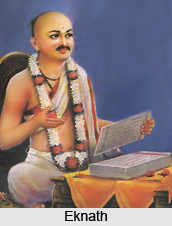 Eknath was one of the most popular among the saints of the famous Varakavi Sampradaya founded by Gyanadeva. He was born in the year of 1533 at Paithan and as his parents passed way very early in his life, he could not receive much parental love. He got his first spiritual education from one of the devotees of Dattatreya, named Guru Janardana, at a very young age and he was unique as he represented a blend of Vedanta and Sufism. He was one of the most earnest `gurubhakta` and he wrote his hymns and various religious writings by the name of Eka-janardana that means `eka of Janardana`.
Eknath was one of the most popular among the saints of the famous Varakavi Sampradaya founded by Gyanadeva. He was born in the year of 1533 at Paithan and as his parents passed way very early in his life, he could not receive much parental love. He got his first spiritual education from one of the devotees of Dattatreya, named Guru Janardana, at a very young age and he was unique as he represented a blend of Vedanta and Sufism. He was one of the most earnest `gurubhakta` and he wrote his hymns and various religious writings by the name of Eka-janardana that means `eka of Janardana`.
In his entire life, Eknath successfully propagated two forms of bhakti to the Saguna Brahman, as an end in it and as a means. In general, the Advaitic tradition identifies with the latter, that is as a means, as the meditation of God with form does not lead to moksha (liberation) but only to Krama-mukti (gradual liberation).
Eknath was one of the pioneer reformers of untouchability of Maharashtra. He openly showed courtesy towards the lower caste people. Once he rescued one Mahar child from drowning by the over flowed water of Godavari.His teachings can be summarized as "Vichar, Uchchar and Achar".
Eknath was also a very good and a prolific writer and he has written a number of books in his lifetime. The books like `Bhawartha Ramayana` and also numerous `Abhangas` and `Bharudas`, written by him have become quite popular among the masses. Eknath has popularized the Vedanta philosophy to a great extent, through his Bhagavata and he also wonderfully explains the nine traditional limbs of the `Bhakti marga` with examples from various saints. Eknath wrote a scholarly and lucid commentary, Eknathi Bhagawat.
His other works include Shukashtak, the Swatma-Sukha , the Ananda-Lahari, the Chiranjeewa-Pad, the Geeta-Sar, and the Prahlad-Wijaya. He introduced a new form of Marathi the religious song called Bharood, writing 300 of them.
This eminent personality got samadhi himself by immersing himself in a body of water, such as a lake or a river. He cuddled sacred `jalsamadhi` in the sacred Godavari in the year 1599 following the example of his idol, Dnyaneshwar.




















